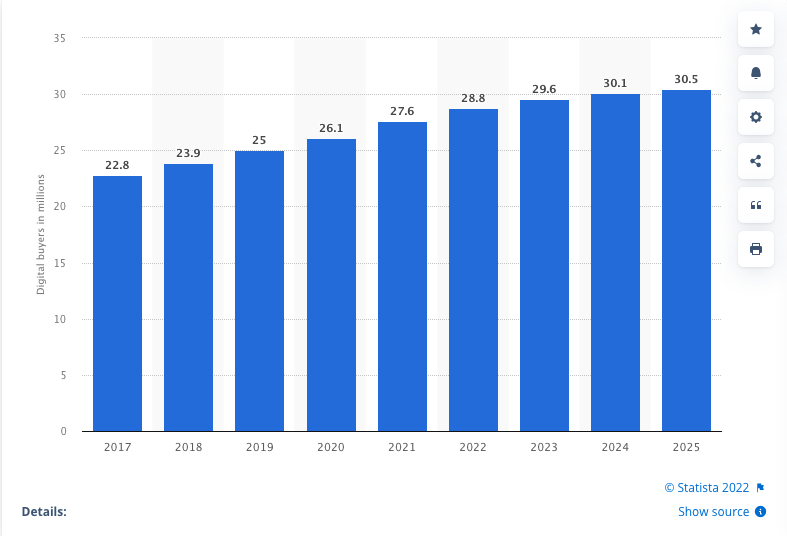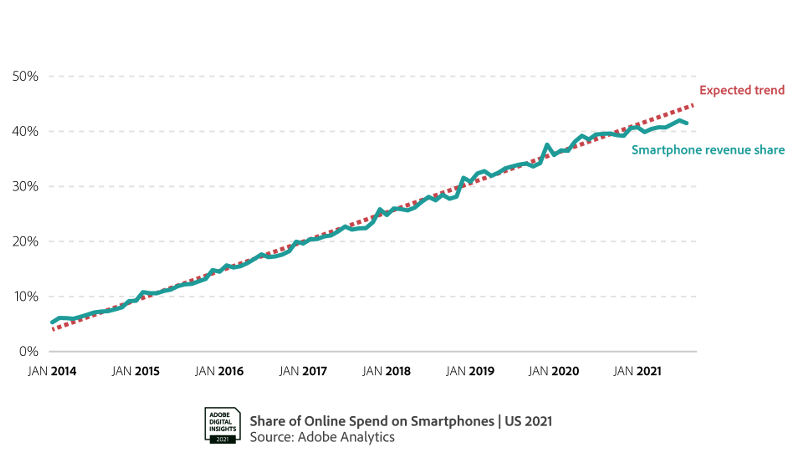Over the past couple of years, shopping online has never been stronger during the holiday season. Post-pandemic, eCommerce has moved online and consumers’ shopping behavior has dramatically changed. Same as new market trends have emerged. Today, there are many new shopping trends for retailers to follow. Saying this, it is very important for retailers to constantly learn about their consumers’ dynamic behavior as well as the new emerging market trends in preparation for their next 2022-23 holiday shopping season.
The main obvious trend retailers can see, there is a clear shift in consumer preference, shopping behavior, and demographics. According to Statista, the Number of digital buyers in Canada from 2017 to 2025 is increasing.

Also, today, shopping on smartphones is hitting a plateau this year, according to the 2022 HOLIDAY SHOPPING TRENDS & INSIGHTS REPORT. According to Adobe Commerce, the total estimated season revenue is 209.7 billion dollars this season. Here is how much consumers are spending during the holiday season.


Over the last few years, eCommerce has increasingly shifted to digital. Statista, showed that in 2020, the number of digital buyers increased dramatically. Over two billion digital buyers and e-retail sales surpassed 4.2 trillion U.S. dollars worldwide. In 2021, retail e-commerce sales amounted to approximately 5.2 trillion U.S. dollars worldwide. This figure is forecast to grow by 56 percent over the next years, reaching about 8.1 trillion dollars by 2026.

Retailers: Discover the Key Emerging Shopping Trends Shaping the Retail Industry
DigiCommerce expects that margins will become even narrower as baby boomers will continue adopting technology. For example, when it comes to consumer goods and groceries. Consumers are increasingly adopting technology access for the sake of convenience, greater flexibility of purchase options, and above all saving time!
Here are some key emerging shopping trends consumers are adopting nowadays and for retailers to integrate into their strategy:
1. Capitalize on BOPIS Trend
BOPIS stands for buy-online-pickup-in-store. This trend has been increasingly growing preference for consumers lately. Consumers are more comfortable browsing and purchasing online, and picking up purchases in stores. This trend allows retailers to blend the online and in-store experience to engage customers by offering a convenient, fast, and hassle-free way to shop. Same as curbside pick up where customers pick up their purchases outside the store without even leaving their cars. Same as, buying online and returning in-store, or reserving online and picking up in-store. This trend allows customers to order their purchases online, but not actually pay for them until they receive them in-store.
Online customers today want their purchases fast and with minimal cost of shipping. This option is very attractive for customers because they are saving on shipping fees. BOPIS is indeed one of the key trends retailers need to learn and adapt in their business strategy in preparation for their next shopping season.

2. Customize Mobile Apps
Today retailers should offer their branded apps for customers to order from. This platform should provide accurate and real-time visibility into available inventory. Also, with the increase of using smartphones for shopping, apps have become the most convenient way of shopping. Especially when it comes to BOPIS. Consumers can shop for their goods using apps, they can also choose which store to pick up their purchases according to their availability. This indeed enhances a reliable, efficient, smart, and convenient shopping experience for customers.
In addition to that, retailers can retain their customers by communicating with them using push notifications throughout their shopping journey. For example notifying them when their order is being prepared, when it is ready to be picked up, and confirming their delivery. All this through their mobile devices. Customers’ shopping behavior and preferences have changed. Thus, retailers should digitally transform their online stores and create their branded apps to accommodate their customers’ shifting buying behavior.
3. Embrace BNPL Trend
The buy now, pay later (BNPL) trend increasing over the past year and continues to grow. Consumers are using BNPL for increasingly less expensive orders with a minimum order value of $225, reflecting a 12% drop from 2020 to 2021, according to Adobe Analytics. Adobe digital insights’ key findings are that BNPL orders in 2021 are 44% above the same period in 2019, and 3% higher than in 2020. Revenue in 2021 is 45% above the same period in 2019 and 10% higher than in 2020. Thus, no doubt in preparation for next year’s shopping season, retailers need to embrace the BNPL trend and reconfigure their eCommerce platforms to allow orders to pay a certain percentage of the full amount once consumers are checking out their goods. This is indeed one of the key lessons retailers are learning about this shopping season.
4. Set up Chatbots
Engage your customers by setting up chatbot automation for your online store. Chatbots leverage machine learning, NLU (Natural Language Understanding). They are an excellent way to communicate and engage with your customers. If your customers have questions and would like to connect with you, this is the modern online way where you can respond to their questions spontaneously.
If you do not have enough resources to help your customers answer common questions, then here is where chatbots may come in place. It will not only reduce response times to your customers, but also help increase your customer satisfaction, and boost your sales over time. Indeed, this is a great key selling tool every retailer needs to adopt on their online store for engaging with their customers, especially during holiday shopping!
5. Advertise on Social Media

Expanding your presence on social media goes without saying. In fact, shoppers nowadays are appreciating more and more the conveniences that the omnichannel shopping experience can provide. Especially shopping on social platforms like Instagram and Facebook trend offers a great opportunity for businesses to target their potential customers and engage with their audience. You can take advantage of these platforms to showcase your products, and reviews, and advertise promotions and discounts. DigiCommerce in partnership with BigCommerce offers integration with Facebook and Instagram to help retailers benefit from these social platforms to increase their sales. You can leverage the power of social media to outreach out to your potential customers and maximize revenue.
Adopting these trends, retailers, and business to businesses should upgrade their eCommerce shopping platforms. Their storefront experience should be easy to use. Retailers should adopt a flexible modern architecture that allows tailoring their shopping experience according to the customers’ preferences. Their platforms should be equipped with features like quick order, one-click check out, and re-order, flexible payment methods, flexible return policy, and the ability for shipping or pick up at the store. DigiCommerce Headless Commerce Solution helps retailers to optimize how they do business with their customers.
Retailers: Prepare for the next Shopping Season
ECommerce now is made easy with the interface between different storefronts B2B, B2C & D2C. DigiCommerce Headless Commerce Solution helps businesses and retailers to optimize how they do business with their customers. This solution has a flexible and modern structure that you can seamlessly implement and deploy with your current existing platform, if you already have one in place, to facilitate your customers’ shopping experience.
To wrap up, due to the dramatic shifts in consumer preferences, shopping behavior, and demographics, and with increasing growth and demand for these new trends over the past few years, retailers and businesses have no choice but to adopt these emerging shopping trends into their eCommerce platforms in order to gain full potential of the next shopping season.

